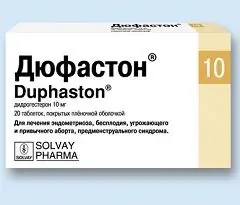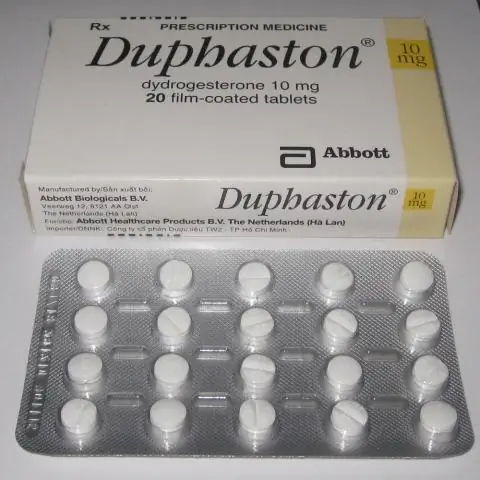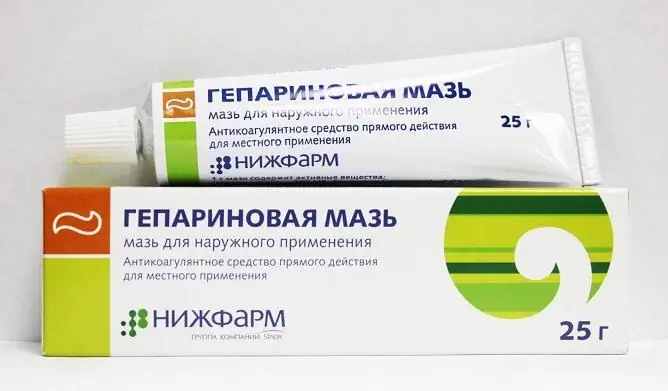- Author Rachel Wainwright [email protected].
- Public 2023-12-15 07:39.
- Last modified 2025-11-02 20:14.
Duphaston
Duphaston: instructions for use and reviews
- 1. Release form and composition
- 2. Pharmacological properties
- 3. Indications for use
- 4. Contraindications
- 5. Method of application and dosage
- 6. Side effects
- 7. Overdose
- 8. Special instructions
- 9. Application during pregnancy and lactation
- 10. Use in childhood
- 11. In case of impaired renal function
- 12. For violations of liver function
- 13. Drug interactions
- 14. Analogs
- 15. Terms and conditions of storage
- 16. Terms of dispensing from pharmacies
- 17. Reviews
- 18. Price in pharmacies
Latin name: Duphaston
ATX code: G03DB01
Active ingredient: Dydrogesterone (Dydrogesterone)
Producer: Solvay Biologicals BV, Abbott Biologicals BV (Netherlands)
Description and photo update: 2019-06-08
Prices in pharmacies: from 507 rubles.
Buy

Duphaston is a gestagenic drug.
Release form and composition
Dosage form - coated tablets: white, round biconvex with beveled edges and a dividing line on one side, on both sides of the risk there is an engraving "155" (20 pcs. In blisters, 1 blister in a cardboard box).
The active substance is dydrogesterone, in 1 tablet - 10 mg.
Auxiliary components: hypromellose, lactose monohydrate, corn starch, magnesium stearate, colloidal silicon dioxide.
Shell composition: white opadry Y-1-7000 (polyethylene glycol 400, hypromellose, titanium dioxide (E171)).
Pharmacological properties
Pharmacodynamics
Dydrogesterone is a progestogen that is active when taken by mouth. In its molecular structure, pharmacological and chemical properties, it is very close to natural progesterone.
Dydrogesterone does not have the side effects characteristic of most "androgenic" progestogens (synthetic progestogens), since it is not a testosterone derivative. It also lacks androgenic, estrogenic, thermogenic, glucocorticoid and anabolic activity.
Dydrogesterone is used in HRT (hormone replacement therapy) as a progestogenic component that helps to maintain the beneficial effect of estrogens on the lipid composition of the blood. At the same time, dydrogesterone does not affect coagulation indices, which distinguishes it from estrogens, which, as a rule, have a negative effect on the blood coagulation system.
The drug does not adversely affect liver function and carbohydrate metabolism.
When taken orally, dydrogesterone selectively affects the uterine mucosa, thereby preventing an increased risk of malignant tumors and / or endometrial hyperplasia with an excess of estrogen.
Duphaston is indicated in all cases of endogenous progesterone deficiency. The drug has no contraceptive effect.
The therapeutic effect of drug treatment is achieved without disturbing menstrual function or suppressing ovulation. The drug makes conception possible and preserves the onset of pregnancy.
Pharmacokinetics
Dydrogesterone is rapidly absorbed from the gastrointestinal tract after oral administration. The maximum plasma concentration is reached after 2 hours. Dydrogesterone is 97% bound to plasma proteins.
Metabolized in the liver. Metabolism is carried out by hydroxylation of ketone groups of the 20th carbon atom, methyl groups of the 21st carbon atom and methyl groups of the 16-α carbon atom (in a small amount).
From 56 to 79% is excreted in the urine. After a day, about 85% of the drug is excreted, and after 72 hours the process of excretion of Duphaston practically ends.
With limited renal function, there was no delay or increase in the action of dydrogesterone. The metabolites of the drug are found in urine mainly in the form of glucuronic acid conjugates. Dydrogesterone in unchanged form in urine is not detected.
Indications for use
The use of Duphaston is indicated for women with progesterone deficiency. The characteristic symptoms of progesterone deficiency are:
- Infertility due to luteal insufficiency;
- Endometriosis;
- Miscarriage, threatening or habitual (against the background of progesterone deficiency);
- Secondary amenorrhea (in combination therapy with estrogens);
- Dysfunctional uterine bleeding;
- Premenstrual syndrome;
- Irregular menstruation, dysmenorrhea.
In addition, the drug is used in the form of hormone replacement therapy to neutralize the proliferative effect of estrogens on the endometrium in patients with disorders caused by surgical or natural menopause with an intact uterus.
Contraindications
- Lactase deficiency, galactose and glucose intolerance, malabsorption syndrome;
- Breastfeeding period;
- Hypersensitivity to drug components.
If the patient has a history of pruritus during a previous pregnancy, Duphaston should be used with caution.
Instructions for use of Duphaston: method and dosage
The tablets are taken orally.
A single dose of the drug is 10 mg, the frequency of administration and the period of treatment depend on the clinical indications:
- Endometriosis: 2-3 times a day continuously or from the 5th to the 25th day of the menstrual cycle;
- Infertility due to luteal insufficiency: 1 time per day from the 14th to the 25th day of the cycle, continuous therapy lasts at least 6 subsequent cycles. During the first months of pregnancy, Duphaston continues to be taken according to the scheme recommended for a routine abortion;
- Threatening abortion: once - 40 mg, then 10 mg is taken every 8 hours until the condition stabilizes;
- Habitual miscarriage: 2 times a day until the 20th week of pregnancy, then the dose should be gradually reduced;
- Premenstrual syndrome: 2 times a day from the 11th to the 25th day of the cycle;
- Dysmenorrhea: 2 times a day from the 5th to the 25th day of the cycle;
- Irregular menstruation: 2 times a day from the 11th to the 25th day of the cycle;
- Amenorrhea: in combination with estrogens (they are prescribed once a day from the 1st to the 25th day of the cycle) Duphaston is taken 10 mg 2 times a day from the 11th to the 25th day of the cycle;
- Dysfunctional uterine bleeding: 2 times a day, the course of therapy is 5-7 days;
- Prevention of dysfunctional uterine bleeding: 2 times a day from the 11th to the 25th day of the cycle;
- Hormone replacement therapy: with continuous administration of estrogens, the drug is prescribed 10 mg once a day for 14 days (with a menstrual cycle of 28 days), and with a cyclic scheme of estrogen therapy - during the last 12-14 days of estrogen use. In case of an inadequate response to progestogen therapy, confirmed by ultrasound or biopsy, it is recommended to increase the daily dose to 20 mg.
Side effects
- From the hepatobiliary system: rarely - minor functional disorders of the liver, accompanied by malaise, weakness, sometimes pain in the abdomen or jaundice;
- On the part of the hematopoietic system: in isolated cases - hemolytic anemia;
- From the nervous system: headache, migraine;
- From the immune system: very rarely - hypersensitivity reactions;
- On the part of the skin and subcutaneous tissue: allergic reactions, in the form of itching, rash, urticaria; very rarely - Quincke's edema;
- From the reproductive system: rarely - hypersensitivity of the mammary glands, breakthrough uterine bleeding, which can be prevented by increasing the dose;
- Others: very rarely - peripheral edema.
Overdose
To date, no cases of overdose of Duphaston have been reported. In case of accidental intake of the drug in doses significantly higher than therapeutic, it is recommended to perform gastric lavage.
In case of an overdose, treatment is symptomatic, there is no antidote for dydrogesterone.
special instructions
In case of breakthrough bleeding, it is necessary to increase the dose of the drug.
With hormone replacement therapy and other cases of combined administration of Dufaston with estrogen drugs, it is necessary to take into account the contraindications and recommendations associated with their use.
It is recommended to start carrying out hormone replacement therapy only after collecting a complete history; during treatment, individual tolerance should be periodically monitored. The patient should be informed about what symptoms of changes in the mammary glands should be reported to the doctor. Mammography and other tests are performed in accordance with generally accepted screening for patients.
An accurate assessment of the benefits and risks of hormone replacement therapy can be determined over time.
In the event of breakthrough uterine bleeding during or after a course of therapy, an endometrial biopsy should be performed to exclude malignant neoplasms.
If the patient has a history of indications of the presence of a progesterone-dependent tumor (for example, meningioma), as well as in case of its progression during previous hormone therapy or during pregnancy, Duphaston should be used after a thorough examination.
The drug does not affect the ability to drive vehicles and mechanisms.
The use of Duphaston during pregnancy and lactation
According to the instructions, Duphaston during pregnancy is used according to indications.
Since dydrogesterone can be excreted in breast milk, it is recommended to stop breastfeeding if drug treatment is necessary.
Pediatric use
The drug is not used in pediatric practice.
The drug can be prescribed to girls in adolescence with menstrual irregularities (the appropriateness of the use of dydrogesterone and the dosage is determined by the doctor).
With impaired renal function
Dydrogesterone is prescribed with caution to patients with impaired renal function.
For violations of liver function
In severe liver diseases, the use of the drug is contraindicated. For mild and moderate impairment of liver function, Dufaston is used with caution.
Drug interactions
Simultaneous use with rifampicin, phenobarbital and other inducers of microsomal liver enzymes can accelerate the metabolic processes of dydrogesterone and reduce the effectiveness of the drug.
No clinically significant cases of incompatibility of Duphaston with other drugs have been established.
Analogs
Duphaston's analogues are: Prajisan, Utrozhestan, Progesterone in ampoules.
Terms and conditions of storage
Store in original packaging in a dry place at temperatures up to 30 ° C. Keep out of the reach of children.
The shelf life is 5 years.
Terms of dispensing from pharmacies
Dispensed by prescription.
Reviews about Duphaston
According to reviews, Duphaston increases the likelihood of conception (with the correct diagnosis and adherence to the treatment regimen), significantly alleviates the symptoms that appear during the climacteric period, and is effective for endometriosis, ovarian cysts and polycystic ovaries.
After the course of treatment, the menstrual cycle stabilizes in most patients. There is also evidence of the effectiveness of the drug in uterine fibroids.
Among the adverse reactions described by women who took Duphaston, the most common were nausea, abdominal pain, loose stools, general weakness, and weight gain. However, despite the unwanted side effects, positive reviews of the drug are more common.
The price of Dufaston in pharmacies
The drug can be purchased from pharmacies with a prescription. The price for Dufaston in a dosage of 10 mg (20 pcs. In a package) is 500-560 rubles.
Duphaston: prices in online pharmacies
|
Drug name Price Pharmacy |
|
Duphaston 10 mg film-coated tablets 20 pcs. 507 r Buy |
|
Duphaston tab. p / o captivity. 10mg No. 20 564 RUB Buy |
|
Duphaston 10 mg film-coated tablets 28 pcs. 704 RUB Buy |
|
Duphaston tab. p / o captivity. 10mg No. 28 784 RUB Buy |

Anna Kozlova Medical journalist About the author
Education: Rostov State Medical University, specialty "General Medicine".
Information about the drug is generalized, provided for informational purposes only and does not replace the official instructions. Self-medication is hazardous to health!






